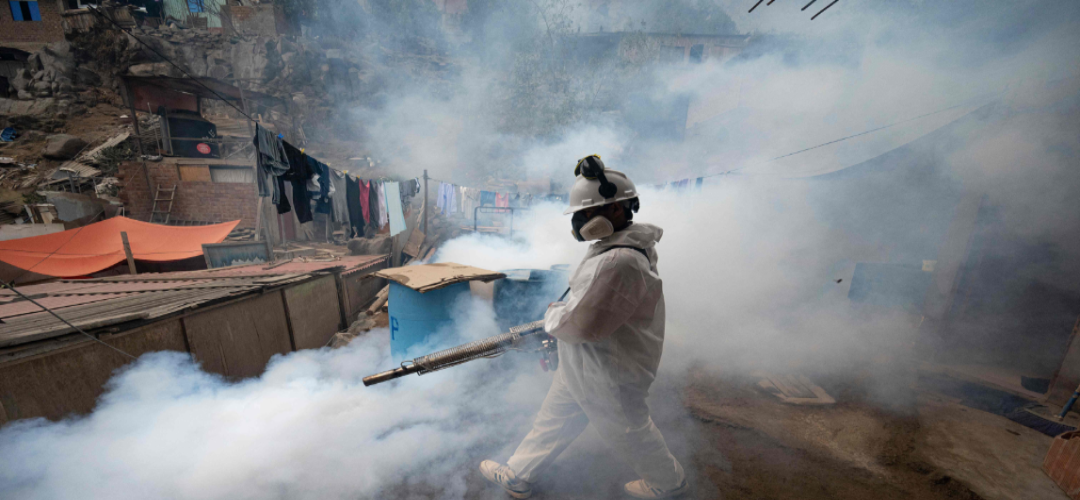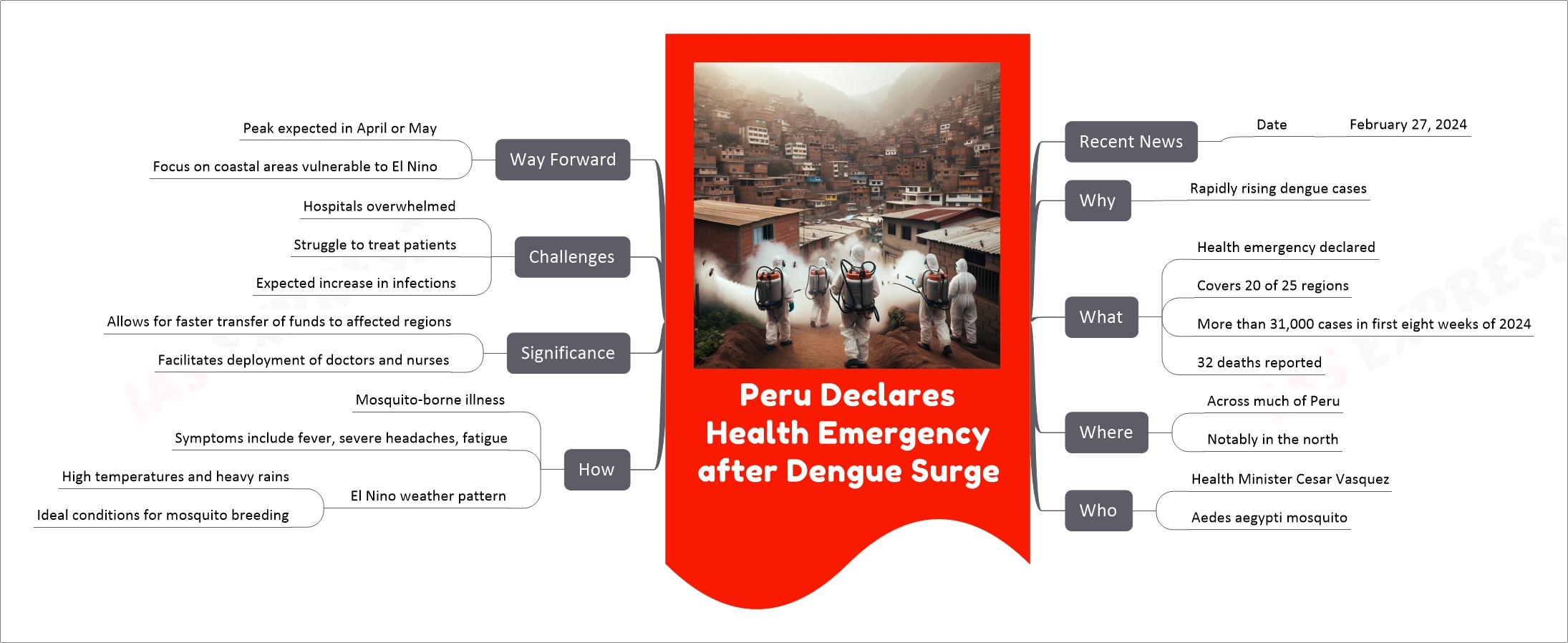Peru Health Emergency Due to Dengue Spike
March 9, 2024 | Expert Insights

As of February 2024, over 31,000 cases and 32 deaths have been reported, with the majority concentrated in the northern regions of Piura and La Libertad. This drastic rise in infections has overwhelmed local healthcare facilities, prompting the government to take swift action.
Background
This is not the first time Peru has grappled with a significant dengue outbreak. In 2023, the country witnessed its worst dengue epidemic to date, with over 270,000 cases and 400 deaths reported. While the current outbreak hasn't yet reached the scale of the previous year, the rapid rise in cases and the potential for further escalation prompted the government to declare a health emergency as a precautionary measure.
The World Health Organization (WHO) estimates that around 400 million individuals contract dengue annually, with at least 100 million experiencing symptoms. This number represents a significant rise from the half a million cases reported globally in the early 2000s. This increasing trend highlights the growing global public health challenge posed by dengue fever.
Understanding the factors contributing to this rise in dengue cases is crucial for developing effective mitigation strategies. The increasing urbanization of previously rural areas creates ideal breeding grounds for mosquitoes, the primary vectors of the virus. Additionally, climate change, with its associated fluctuations in temperature and rainfall patterns, can further exacerbate the problem. Compounding these environmental factors is the lack of widespread access to effective preventative measures like vaccines and the absence of robust public health infrastructure in many vulnerable regions.

Analysis
The recent surge in dengue fever cases in Peru serves as a concerning reminder of the intricate link between climate change and public health challenges. This outbreak, attributed in part to the ongoing El Nino phenomenon, highlights the potential for changing weather patterns to create ideal breeding grounds for disease-carrying vectors like mosquitoes, consequently amplifying the risk of infectious diseases.
El Nino disrupts typical weather patterns, leading to increased precipitation and warmer temperatures in Peru. These conditions create an ideal environment for the Aedes Aegypti mosquito, the primary vector of dengue fever, to thrive and propagate. The increased mosquito population serves as a critical factor in the observed rise in dengue cases, as it amplifies the risk of transmission through mosquito bites.
Dengue fever, a mosquito-borne viral infection, manifests with a range of symptoms, including high fever, severe headaches, fatigue, nausea, vomiting, and muscle and joint aches. In severe cases, it can progress to a potentially life-threatening complication known as dengue haemorrhagic fever. The current situation in Peru underscores the potential impact of climate change on the spread and severity of infectious diseases like dengue.
The El Niño phenomenon, exacerbated by global warming, provides fertile ground for mosquito-borne illnesses like dengue. This case study serves as a stark reminder of the interconnectedness between environmental changes and public health concerns. The alteration of weather patterns associated with El Nino creates favourable conditions for mosquito breeding, leading to increased transmission of mosquito-borne diseases.
The immediate response to the dengue surge in Peru, while crucial, cannot be the sole focus. Building long-term resilience against future outbreaks demands a multifaceted approach that addresses not just the immediate crisis but also the underlying factors contributing to the rise in cases. Strengthening public health infrastructure, particularly in vulnerable regions, is paramount. This requires investments in healthcare facilities, ensuring adequate staffing with trained medical professionals, and equipping them with necessary diagnostic tools and treatment protocols. Robust surveillance systems are also crucial to detect outbreaks early, enabling rapid response and containment measures.
Investing in research and development remains vital. Continued efforts are needed to create effective and accessible vaccines to provide long-term protection against dengue fever. Additionally, exploring and developing innovative vector control strategies, such as targeting mosquito breeding grounds or employing biological control methods, can significantly reduce transmission risks.
Combating the rise of dengue fever necessitates venturing beyond the realm of healthcare and addressing the environmental and social factors that contribute to the problem. Urbanization, a significant driver of economic growth, often comes with the unintended consequence of creating stagnant water sources in poorly planned or under-resourced communities. These stagnant water bodies become ideal breeding grounds for the Aedes aegypti mosquito, the primary vector of dengue fever.
Therefore, implementing sustainable urban planning practices is crucial to minimize potential mosquito breeding sites. This can involve incorporating green infrastructure like natural drainage systems and promoting proper waste management to eliminate potential water accumulation sites. Additionally, community education and engagement initiatives can empower residents to identify and eliminate potential mosquito breeding grounds in their immediate surroundings.
Furthermore, ensuring widespread access to clean water and sanitation facilities in vulnerable communities plays a vital role in reducing the dependence on unsafe water storage practices. Often, the lack of readily available clean water compels individuals to store water in containers, which inadvertently creates breeding grounds for mosquitoes. By providing access to reliable and safe water sources, coupled with proper sanitation facilities, communities can significantly reduce their vulnerability to mosquito-borne diseases like dengue fever.
Assessment
-
- Addressing these environmental and social factors, in conjunction with robust healthcare measures, presents a holistic approach to tackling the challenge of dengue fever. This comprehensive strategy can pave the way for a more sustainable and resilient future, safeguarding vulnerable populations from the devastating consequences of this widespread disease.
- The current situation in Peru serves as a stark reminder of the interconnectedness between environmental changes, public health, and socio-economic factors. By adopting a multifaceted approach encompassing proactive public health measures, robust healthcare infrastructure, continued scientific advancements, and addressing the underlying environmental and social factors, we can collectively build resilience against future outbreaks and shield vulnerable populations from the devastating consequences of dengue fever.
- Global collaboration and commitment are needed to ensure that the lessons learned from the current crisis translate into concrete actions and sustainable solutions for the future.








Comments